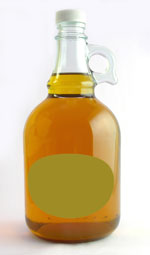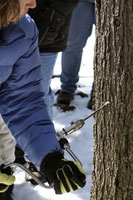 Calling Vermont winters “long” is like saying I have “salt-and-pepper” hair. My hair is gray, the winters are endless, and even the craggiest New Englanders start to get a little squirrelly once Christmas is over. This situation is exacerbated by something called, “the January Thaw;” a cruel, meteorological joke which, somehow, allows the weather to warm up sufficiently for a couple of days to melt all the snow. This sends giddy people who ought to know better, rushing onto the roads in jogging shorts and into their yards to chip golf balls. Then 48 hours later, another storm thunders in, the temperature plunges below zero and everyone slinks back inside to retrieve their long underwear from laundry baskets and fire up their wood stoves.
Calling Vermont winters “long” is like saying I have “salt-and-pepper” hair. My hair is gray, the winters are endless, and even the craggiest New Englanders start to get a little squirrelly once Christmas is over. This situation is exacerbated by something called, “the January Thaw;” a cruel, meteorological joke which, somehow, allows the weather to warm up sufficiently for a couple of days to melt all the snow. This sends giddy people who ought to know better, rushing onto the roads in jogging shorts and into their yards to chip golf balls. Then 48 hours later, another storm thunders in, the temperature plunges below zero and everyone slinks back inside to retrieve their long underwear from laundry baskets and fire up their wood stoves.
Around Valentine’s Day, however, we start to get indications that liberation, in the form of an actual spring, is on the way. Even though it’s still so cold the air is blue, seed catalogs being arriving in the mail. Next, we read in the paper that the Red Sox are heading to spring training. Soon we’ll actually be able to see them running around on the field down in Florida if a nor’easter doesn’t knock out the satellite dish.
 Then, usually in March, there comes a time when the nights are still below freezing but the days are actually above freezing. That means the sap is “running” in the maple trees and we get to stop reading and watching and actually participate in our grand rite of spring—making maple syrup.
Then, usually in March, there comes a time when the nights are still below freezing but the days are actually above freezing. That means the sap is “running” in the maple trees and we get to stop reading and watching and actually participate in our grand rite of spring—making maple syrup.
It’s a time-honored tradition (Is there any other kind?) in New England and Quebec, and has the requisite lore, rituals and rules.
First rule of Making Maple Syrup--Don’t call it Making Maple Syrup. It’s called “sugaring.” The people who do it are “sugar makers,” and the places they make it are “sugar houses.” These installations range from nicely-finished cabins containing sophisticated, expensive equipment, such oil burners and Osmosis Machines, to backyard “rigs” like the one my neighbor and I use. Ours consists of a flat (2’ x 4’) pan which sets over a wood fire burning inside an “arch” made from half an oil drum. We talk about covering the operation with tarp on poles, but we’ll never do it.
Of course, no matter how sophisticated or primitive the equipment, the object is the same--to boil the sap into syrup. First though, you have to get the sap out of the trees. You do this by “tapping” a tree-- driving a tap into the trunk with a hammer. Then, you either hook a bucket onto the tap or (as backyard folks do) or connect the tap to a piece of plastic tubing as the large sugar makers do. (Some medium-sized sugar makers are die-hard traditionalists and gather their sap from buckets with a team of horses pulling a sled through the woods, or “sugarbush”. It’s picturesque, but not efficient.)
 However it’s gathered, the sap eventually ends up in a holding tank and now it’s time to start boiling. Get comfortable, it’s going to be a while. It takes 40 gallons of sap to make one gallon of syrup because sap has a very low sugar content. In fact, right out of the tree, it tastes like water. This makes the story of Native Americans discovering maple syrup by “accident” seem very suspect.
However it’s gathered, the sap eventually ends up in a holding tank and now it’s time to start boiling. Get comfortable, it’s going to be a while. It takes 40 gallons of sap to make one gallon of syrup because sap has a very low sugar content. In fact, right out of the tree, it tastes like water. This makes the story of Native Americans discovering maple syrup by “accident” seem very suspect.
Fortunately, to help pass the hours you have lots of visitors. Most of them come around hoping for a free beer (you’ll also need plenty of beer) and the promise of a pint of syrup at the end of the day. To ensure that result, they’ll always be quite complementary about your work, inevitably referring to it as, “liquid gold.” One word of caution, between the beer and the compliments, it’s easy to commit to giving away more syrup than you can possibly produce. Then, to meet your obligations, you have to buy syrup from other sugar makers (or even at the store) and put it into your jars with your label. It’s very embarrassing and expensive. Don’t ask me how I know this.
Most people think maple syrup is just for pouring over pancakes and waffles. However, as people up here know, it’s great for cooking and we use it in all sorts of things where sweetener is called for, as well as maple-specific dishes such as maple candy and maple syrup pie. Then, there’s sugar-on-snow, which is just what it sounds like. I recommend using new-fallen snow harvested prior to letting your dog out for a run.
My neighbor and I tap about twenty trees, most of which are located on the banks of the creek that divides our property. I find it gloriously refreshing, in every sense of the word, to go out on a sunny day to tap the trees and hang the buckets as the icy-water rushes over the rocks in the creek bed. We gather enough sap to make about five gallons of syrup over two weekends. Of this, he takes 60 per cent, which is a great deal for me since he does 70 per cent of the work and has 90 percent of the expertise. However, I must admit, I minimize (or even omit) his contribution when telling the guests at our bed and breakfast how the wonderful topping for their French Toast came to be.
There’s a lot more to know about sugaring such as grades of syrup, how hydrometers work and the role of gravity. You can check it all out on line at maplemuseum.com.
One thing I can tell you though, before you tap a tree, make sure it’s a sugar maple as opposed to any other kind of maple. Otherwise, you won’t get any sap, but you will get plenty of ridicule from the locals--even more than when you ran the lawnmower into the pond. Don’t ask me how I know this.
 MAPLE SYRUP PIE
MAPLE SYRUP PIE
Adapted from GOURMET MAGAZINE, November 1999
Pastry Dough
1½ cups packed light brown sugar
2 large eggs at room temperature
½ cup heavy cream
1/3 cup maple syrup (preferably dark amber)
2 teaspoons unsalted butter, melted
Pre-heat oven to 350° F.
Roll out dough into an 11-inch round on a lightly-floured surface with a floured rolling pin and fit into an 8-inch (3-cup) glass pie plate. Trim excess dough and crimp edges decoratively
In a bowl, mix brown sugar and eggs with a whisk until creamy. Add cream, syrup and butter, and continue beating until smooth. Pour filling into pie shell.
Bake pie in lower third of oven until pastry is golden and filling is a little puffed but filling still trembles, 50-60 minutes. Cool on a rack. The filling will set as it cools.
Serve with crème fraiche or barely sweetened heavy cream, barely sweetened, you really need this to offset the sweetness of the pie.
Tom Maxwell is a former director of The Groundlings and TV writer. He now lives in Vermont where he and his wife operate Fairy Tale Farm Bed and Breakfast.

